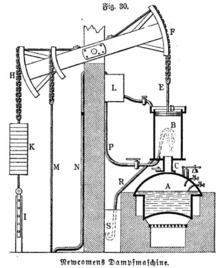Thomas Newcomen
| Thomas Newcomen | |
|---|---|
| Narození | 24. února 1663 Dartmouth |
| Úmrtí | 5. srpna 1729 (ve věku 66 let) Londýn |
| Místo pohřbení | Bunhill Fields Burial Ground |
| Povolání | vynálezce, obchodník s železářským zbožím a mechanik |
| Nábož. vyznání | baptisté |
| Některá data mohou pocházet z datové položky. Chybí svobodný obrázek. | |

Thomas Newcomen (24. února 1664 Dartmouth v hrabství Devon – 5. srpna 1729 Londýn) byl anglický kovář a vynálezce, tvůrce prvních parních strojů. V roce 1712 sestrojil se svým společníkem Thomasem Saverym parní stroj pro čerpání vody z dolů. Do roku 1733, než vypršel patent, byla takových strojů sestavena více než stovka.
Své experimenty prováděl od roku 1705, možná s pomocí Johna Calleye. Jeho „ohňový stroj“ se brzy rozšířil do mnoha dolů v Anglii i na kontinentě. Později byl jeho vynález vylepšen Jamesem Wattem, který sestrojil oddělený kondenzátor páry. Stroj stále vylepšoval a získal na něj patent v roce 1769, i přes odpor výrobců atmosférických, ohňových strojů.
Ocenění
23. února 2012 vydala Royal Mail poštovní známku s Newcomenovým parním strojem jako součást své série „Britons of Distinction“.[1]
Odkazy
Reference
- ↑ Tom Banks. Purpose designs Britons of distinction stamps. www.designweek.co.uk. Design Week, 23 February 2012. Dostupné online.
Literatura
- Rhys Jenkins: Savery, Newcomen and the Early History of the Steam Engine in The Collected Papers of Rhys Jenkins. Newcomen Society, Cambridge 1936, s. 48-93.
- Lionel Thomas Caswell Rolt: Thomas Newcomen. The Prehistory of the Steam Engine. 1. vyd. David & Charles, Dawlish 1963, s. 158.
- Lionel Thomas Caswell Rolt, John S. Allen: The Steam Engines of Thomas Newcomen. 2. vyd. Moorland Publishing Company, Hartington 1977, ISBN 0903485427, s. 160.
Externí odkazy
 Obrázky, zvuky či videa k tématu Thomas Newcomen na Wikimedia Commons
Obrázky, zvuky či videa k tématu Thomas Newcomen na Wikimedia Commons
Média použitá na této stránce
Newcomen beam engine.
The steam is produced in the boiler A and reaches the cylinder B through the pipe C. The steam in the cylinder forces the piston D upwards, like in Papin’s invention, assisted by the counterweight K. At the piston D the force is coupled via the fixed rod E and in turn by a chain to the beam F. The counterweight K is attached via the chain H to the other side of the beam. The pump rod I is rigidly coupled to the base of the counterweight, being pushed up and down by the corresponding movements of the counterweight. By stopping the flow of steam through pipe C, by use of the stopcock, the contents of the cylinder are closed off. Water from the reservoir L is injected into the cylinder via the pipe P. (This point in the cycle is shown in the illustration). The injected water speeds up condensation of the steam in the cylinder, causing a vacuum. The piston is pushed downward by the air pressure from outside, moving the mechanically coupled beam F as well. This movement lifts the counterweight K and the coupled pump rod I upwards. The pipe R takes away the condensed water, S marks the section of the U-shaped pipe submerged in the reservoir, closing off the cylinder in a steam tight manner.
M is the linkage of a small aŭiliary pump which fills the reservoir L through the pipe N. In the original implementation, the stopcocks were operated manually.